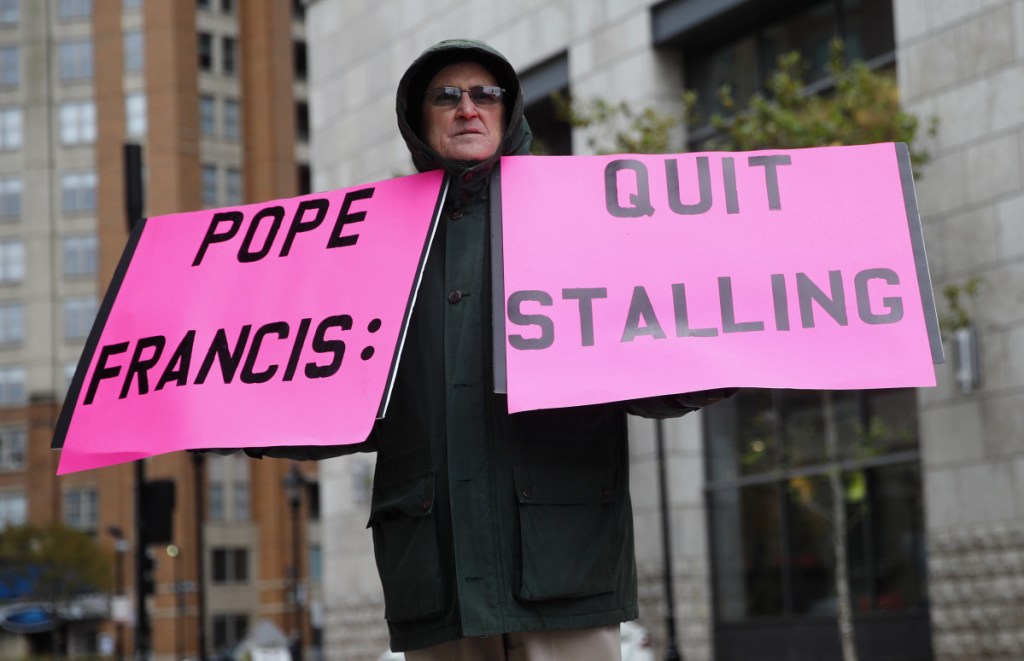The suits demand that the church produce the names of all accused sex offenders.
Two groups of victims of sexual abuse by Catholic clergy members have launched simultaneous lawsuits against the U.S. Conference of Catholic Bishops, with one class-action suit also naming the Holy See as a defendant.
The suit accuses the Catholic church of conspiracy and operating a continuing criminal enterprise under federal racketeering statutes, and seeks to be the first to hold the Vatican liable in the United States for the actions of its clergy.
The suits demand that the church produce the names of all accused sex offenders listed in the church’s secret archives nationwide. Both suits were filed Tuesday, apparently by coincidence, the lawyers said. But the class-action suit, filed in federal court in the District of Columbia, also seeks financial damages for assault, gross negligence, emotional distress and wrongful death, for the families of those who committed suicide after being abused by a priest or other Catholic official.
And the class action seeks to triple those financial damages under the federal Racketeering Influenced and Corrupt Organizations Act, or RICO, originally written to target organized crime but appropriate for a church accused of “cheating and defrauding Plaintiffs and Class members out of their childhood, youth, innocence, virginity, families, jobs, finances, assets – in short, their lives,” according to the lawsuit.
VATICAN LETTER
The suit filed in Washington notes that the Holy See has successfully avoided liability in the United States by claiming it did not have direct authority over priests. But then Monday, as the bishops were meeting at their national conference in Baltimore to address the issue, they were directed by a letter from the Vatican to stop the discussion, and did. “If that’s not command responsibility, I don’t know what is,” said Mitchell A. Toups, one of the lead attorneys in the class-action case.
The second suit, filed in federal court in Minnesota on behalf of six men, was announced Wednesday at a news conference in Baltimore. It was filed by attorney Jeffrey Anderson of St. Paul, who said he has filed thousands of legal actions against the church since 1983 on behalf of abuse victims. One of the plaintiffs in the suit, Joseph McLean of St. Paul, said he agreed to be publicly named in the suit “to force the U.S. Conference of Catholic Bishops to come clean and do the right thing.”
Judy Keane, a spokeswoman for the conference of bishops, said the bishops would not comment on pending litigation. The Holy See, which is the government of the Catholic church based in Vatican City, and maintains the equivalent of an embassy in Washington, did not respond to a request for comment.
The six plaintiffs in each suit are men from different states around the country, and the suits do not discuss the individual abuse any of the plaintiffs suffered. The class-action suit instead revisits the church’s centuries of both child abuse and its supposed steps to halt it, starting in 306 A.D. when a council in Spain “passed the first formal legislation condemning child sexual abuse by the clergy, including sexual abuse of boys.” By 1917, the Holy See formally made it a crime for clergy to have sex with children under the age of 16, and subsequent church laws further codified that ban.
In 1962, the Holy See privately circulated a new set of procedures for dealing with clergy sexual abuse, which the class-action lawsuit said required bishops to refrain from reporting such crimes to local authorities. When the document became public in 2003, Catholic officials said it only mandated secrecy within the church investigative process of certain cases and did not prohibit reporting to civil authorities.
By that time, thousands of cases of abuse had occurred, and accused priests had merely been shifted to other dioceses.
The class-action suit seeks to hold the Vatican responsible for the first time under the legal concept of “respondeat superior,” that a supervisory body is responsible for the actions of its employees. “It’s a military thing,” Toups said. “The command has responsibility for its troops.” He noted that financial settlements paid to victims of clergy abuse “have to go up the chain of command” within the church for final approval.
Toups said the class-action suit could serve as a one-stop national clearinghouse to resolve all cases of abuse, rather than through a series of local suits.
STATUTE OF LIMITATIONS
The suit estimates the proposed class may consist of over 5,000 members, whose names are already known to the church. In addition to financial damages, the suit seeks a declaratory judgment that the church must discipline and report known offenders; institute policies of transparency, to include publishing the names of all offenders; and create protocols to prevent or effectively handle future episodes of abuse. Under state law, most states have statutes of limitations on civil actions of no more than five years, though some states have exceptions for child sexual abuse claims. The class-action suit argues that the statutes of limitations should be tolled because of “fraudulent concealment”: that the church kept its offenses secret.
One of the plaintiffs in the Minnesota suit, Phillip DiWilliams, said that his own suit against the church in Philadelphia was dismissed in 2011 when the church successfully argued his claims were barred by the state statute of limitations. He urged reporters to continue publicizing the reports of clergy abuse. “They’re not going to stop,” DiWilliams said of the church, “until somebody stops them.”
Thompson, the lawyer in the Minnesota case, said that after decades of bringing suits against the Catholic church, “It’s awful that we have to be as active as we are. But it’s a good journey to sit with survivors and whistleblowers, doing something to protect kids, knowing they (the church) are not.”
Send questions/comments to the editors.



Comments are no longer available on this story